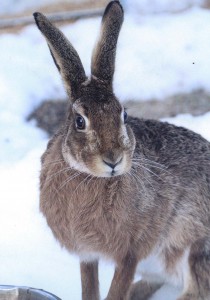 Whilst the first snows of the winter last week may have caused problems in various ways there are a few compensations. One is the chance to go tracking animals in various parts of the countryside such as woodland, moorland or even roadside verges. Tracking in snow is a major way of finding out what animals are around and, to a certain extent, what they are doing. Most animals avoid people mainly because they have been persecuted in the past and to some extent still are. Such animals may just use cover such as holes in the ground, trees and bushes to hide. Others are mainly nocturnal such as badgers, foxes and pine martins. Others such as mice and voles often seem to almost benefit from a snow covering as they simply spent all their time under the snow where they can still tunnel and eat plants and roots. Under the cover of snow they are also away from the prying eyes of predators such as owls and other birds of prey such as kestrels.
Whilst the first snows of the winter last week may have caused problems in various ways there are a few compensations. One is the chance to go tracking animals in various parts of the countryside such as woodland, moorland or even roadside verges. Tracking in snow is a major way of finding out what animals are around and, to a certain extent, what they are doing. Most animals avoid people mainly because they have been persecuted in the past and to some extent still are. Such animals may just use cover such as holes in the ground, trees and bushes to hide. Others are mainly nocturnal such as badgers, foxes and pine martins. Others such as mice and voles often seem to almost benefit from a snow covering as they simply spent all their time under the snow where they can still tunnel and eat plants and roots. Under the cover of snow they are also away from the prying eyes of predators such as owls and other birds of prey such as kestrels.
Contrary to popular belief there is only one land animal in the Highlands that hibernates as such and that is the hedgehog. Some, such as the badger, may not come out to feed every night and they can to a certain extent rely on fat reserves to keep them going but they too have to feed throughout the winter months. Many people believe that red squirrels hibernate but those who are fortunate to have them coming into gardens for food will now be aware that they are busy throughout the year. However, they may, like the badgers, have a rest day or two if the weather is bad and just stay and sleep or rest in their dreys. Other small animals such as the stoat and weasel have problems over finding food at any time of night or day as they are so small they need a regular intake of food.
Whatever strategy animals use to go undetected, once there is a fall of snow their tracks will give them away. It sounds simple but the snow has to be just right. Too much snow and the majority of animal tracks are difficult to recognise and too little will not give clear tracks. The ideal is a covering of around two inches, certainly no more. There is also the time of day because, for example, a fall of snow just before it gets light means that any nocturnal animals will have gone to ground already. Ideally the snow should fall just at dusk and then on more snow until the following day giving plenty of chance to see what has been about. Another problem is that whilst snow in woodland can be particularly productive in tracking animals, the snow cover may be quite different to that outside the trees.
There are probably only two animals that you can track in almost any depth of snow and they are the brown hare and the fox. Most of the tracks by a fox are in a straight line as if the aim is deliberately taking a single line with each paw put in front of the other. The brown hare has an unusual gait in that the forelegs are placed on the ground and the rear ones are brought forward either side and in front of the so called front paws. This combination shows up in all but the deepest snow. I photographed the hare in the snow in a back garden! One of the best books on tracking is “Animals Tracks and Signs” by Preben Bang et al. Published by Oxford University Press at £14.99. The latest reprint, 2011, has an introduction by Ray Mears of TV fame.
